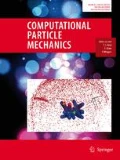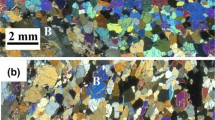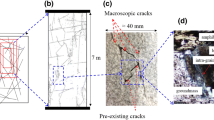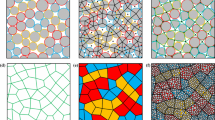Abstract
This paper aims to study the mechanical behavior of rocks using the cohesive crack model (CCM) and grain-based model (GBM) within the distinct element method (DEM) simulations. In the GBM-DEM, the Voronoi tessellation scheme is used and the intact material is simulated as assemblies of a number of particles bonded together at their contact areas. Implemented CCM defines the nonlinear behavior of the grain interfaces under various modes of loading. Numerical simulation of a tension–compression and direct shear tests is conducted to verify the correct implementation of CCM. Moreover, in the application of such a numerical framework, the uniaxial and biaxial compression tests as well as the Brazilian disc test are simulated in the universal distinct element code using a calibration process and then the results are compared with the relevant responses of the rock sample. Finally, the capability of soft computing method, i.e., artificial neural network (ANN) for predicting macromechanical parameters of rock, i.e., UCS based on input cohesive contact shear strength parameters, i.e., cohesion and friction angle, is explored. Results indicate that the ANN model can be quite accurate predictor of uniaxial compressive strength (UCS) and therefore used as a potential tool to aid in estimating target values.











Similar content being viewed by others
References
Kazerani T, Zhao J (2010) Micromechanical parameters in bonded particle method for modelling of brittle material failure. Int J Numer Anal Meth Geomech 34(18):1877–1895
Fabjan T, Ivars DM, Vukadin V (2015) Numerical simulation of intact rock behaviour via the continuum and Voronoi tessellation models: a sensitivity analysis. Acta Geotechnica Slovenica 12(2):4–23
Park JW, Park C, Song JW, Park ES, Song JJ (2017) Polygonal grain-based distinct element modeling for mechanical behavior of brittle rock. Int J Numer Anal Meth Geomech 41(6):880–898
Lorig LJ, Watson AD, Martin CD, Moore DP (2009) Rockslide run-out prediction from distinct element analysis. Geomech Geoeng Int J 4(1):17–25
Shin SW, Martin CD, Park ES, Christiansson R (2007) Methodology for estimation of excavation damaged zone around tunnels in hard rock. In: 1st Canada-US rock mechanics symposium
Alzo’ubi AM (2009) The effect of tensile strength on the stability of rock slopes. PhD Thesis. Edmonton: University of Alberta; p. 205
Lan H, Martin CD, Hu B (2010) Effect of heterogeneity of brittle rock on micromechanical extensile behavior during compression loading. J Geophys Res Solid Earth. https://doi.org/10.1029/2009JB006496
Nicksiar M, Martin CD (2014) Factors affecting crack initiation in low porosity crystalline rocks. Rock Mech Rock Eng 47(4):1165–1181
Gao F, Stead D, Elmo D (2016) Numerical simulation of microstructure of brittle rock using a grain-breakable distinct element grain-based model. Comput Geotech 78:203–217
Mayer JM, Stead D (2017) Exploration into the causes of uncertainty in UDEC grain boundary models. Comput Geotech 82:110–123
Farahmand K, Vazaios I, Diederichs MS, Vlachopoulos N (2018) Investigating the scale-dependency of the geometrical and mechanical properties of a Moderately jointed rock using a synthetic rock mass (SRM) approach. Comput Geotech 95:162–179
Stavrou A, Murphy W (2018) Quantifying the effects of scale and heterogeneity on the confined strength of micro-defected rocks. Int J Rock Mech Min Sci 102:131–143
Itasca (2014) Itasca Consulting Group Inc., The Universal Distinct Element Code (UDEC), Ver. 6.0., Minneapolis, USA
Gao FQ, Stead DOUG (2014) The application of a modified Voronoi logic to brittle fracture modelling at the laboratory and field scale. Int J Rock Mech Min Sci 68:1–14
Nicksiar M, Martin CD (2013) Crack initiation stress in low porosity crystalline and sedimentary rocks. Eng Geol 154:64–76
Kazerani T, Yang ZY, Zhao J (2012) A discrete element model for predicting shear strength and degradation of rock joint by using compressive and tensile test data. Rock Mech Rock Eng 45(5):695–709
Kazerani T (2013) Effect of micromechanical parameters of microstructure on compressive and tensile failure process of rock. Int J Rock Mech Min Sci 64:44–55
Elices MGGV, Guinea GV, Gomez J, Planas J (2002) The cohesive zone model: advantages, limitations and challenges. Eng Fract Mech 69(2):137–163
Zang A, Wagner FC, Stanchits S, Janssen C, Dresen G (2000) Fracture process zone in granite. J Geophys Res Solid Earth 105(B10):23651–23661
Gui Y, Bui HH, Kodikara J (2015) An application of a cohesive fracture model combining compression, tension and shear in soft rocks. Comput Geotech 66:142–157
Hillerborg A, Modéer M, Petersson PE (1976) Analysis of crack formation and crack growth in concrete by means of fracture mechanics and finite elements. Cem Concr Res 6(6):773–781
Evans RH, Marathe MS (1968) Microcracking and stress-strain curves for concrete in tension. Matériaux et Constr 1(1):61–64
Bandis SC, Lumsden AC, Barton NR (1983) Fundamentals of rock joint deformation. Int J Rock Mech Min Sci Geomech Abstr 20(6):249–268
Pine RJ, Owen DRJ, Coggan JS, Rance JM (2007) A new discrete fracture modelling approach for rock masses. Geotechnique 57(9):757–766
Gui YL, Zhao ZY, Ji J, Wang XM, Zhou KP, Ma SQ (2016) The grain effect of intact rock modelling using discrete element method with Voronoi grains. Géotech Lett 6(2):136–143
Kovari K, Tisa A, Einstein HH, Franklin JA (1983) Suggested methods for determining the strength of rock materials in triaxial compression: revised version. Intl J of Rock Mech Mining Sci Geomechanic Abs 20(6):285–290
Haykin S, Haykin SS, Haykin SS, Haykin SS (2009) Neural networks and learning machines, vol 3. Pearson, Upper Saddle River, NJ, USA
Tawadrous AS, DeGagné D, Pierce M, Mas Ivars D (2009) Prediction of uniaxial compression PFC3D model micro-properties using artificial neural networks. Int J Numer Anal Meth Geomech 33(18):1953–1962
Author information
Authors and Affiliations
Corresponding author
Additional information
Publisher's Note
Springer Nature remains neutral with regard to jurisdictional claims in published maps and institutional affiliations.
Rights and permissions
About this article
Cite this article
Fathipour-Azar, H., Wang, J., Jalali, SM.E. et al. Numerical modeling of geomaterial fracture using a cohesive crack model in grain-based DEM. Comp. Part. Mech. 7, 645–654 (2020). https://doi.org/10.1007/s40571-019-00295-4
Received:
Revised:
Accepted:
Published:
Issue Date:
DOI: https://doi.org/10.1007/s40571-019-00295-4




